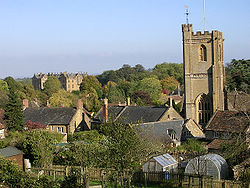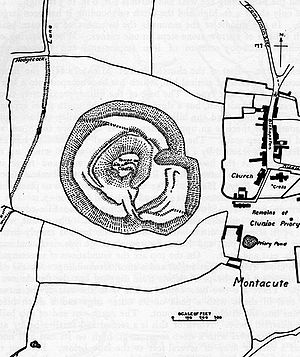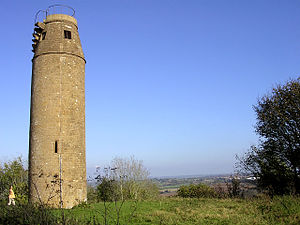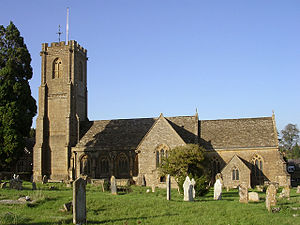Montacute
| Montacute | |
| Somerset | |
|---|---|
 Montacute showing the tower of the Church of St Catherine | |
| Location | |
| Grid reference: | ST4916 |
| Location: | 50°57’0"N, 2°43’12"W |
| Data | |
| Population: | 831 |
| Post town: | Montacute |
| Postcode: | TA15 |
| Dialling code: | 01935 |
| Local Government | |
| Council: | South Somerset |
Montacute is a small village and parish in Somerset, four miles west of Yeovil. The parish has a population of 831,[1] and forms part of the Tintinhull hundred.[2] The name Montacute is thought by some to derive from the Latin "Mons Acutus", referring to the conically acute St Michael's Hill dominating the village to the west. An alternative view is that it is named for Drogo de Montagu, whose family originated from Montaigu-les-Bois, in the arrondissement of Coutances. Mortain held Montacute after 1066, Drogo was a close associate.
The village is built almost entirely of the local hamstone. From the 15th century until the beginning of the 20th century it formed the heart of the estate of the Phelips family of Montacute House. The village has a fine mediæval church, and was the site of a Cluniac priory, the gatehouse of which is now a private house.
At the centre of the village is a large square known as the 'Borough' around which are grouped picturesque cottages and a pub, the Phelips Arms; there is a second public house and hotel situated in the village, called the King's Arms.
History
To the west of the village is the Iron Age hill fort of Ham Hill, a large tribal fort of the Durotriges. The fort was conquered by the Roman Legio II Augusta sometime around AD 45.[3][4] The Romans briefly occupied the fort, then moved to a more permanent garrison at nearby Ilchester (Lindinis), and constructed the Fosse Way Roman road a few miles west of the village.[5] A Roman villa was excavated near Batemoor Barn early in the 20th century and an extensive mosaic documented. Never adequately protected, this has probably been damaged by deep ploughing in the last 20 years.[6]

Variously called Logaresburgh by the Saxons, later Bishopstone or Biscepstone, the estate was owned by Tofig, a staller (placeman or court office-holder) to Danish King Canute.[7] Local tradition remembers Tofig as "Cnut's standard bearer". In 1030 (1035 in some records) following a series of dreams in which the Devil told him where to dig, a local blacksmith found buried on St Michael's Hill a black flint crucifix or Holy Rood. (Some early versions state two black flint crosses were found, one large, one small. Another variant is that the second cross was wooden, and accompanied by a bell and a book/copy of the gospels.) Tofig loaded the life-sized cross (or crosses) onto a cart, and then named a series of possible destinations owned by him.[8] The oxen pulling the wagon (six red and six white in one version of the tale) refused to move until he said Waltham in Essex, where Tofig already had a hunting lodge.[9] They then started, and continued non-stop until they reached Waltham, and where they stopped Tofig decided to build an abbey at the site – this became Waltham Abbey. In the mean time, Tofig rebuilt the church at Waltham to house the cross, on which he bestowed his own sword, and his second wife Gytha (or Glitha), the daughter of Osgod Clapa, adorned the figure with a crown, bands of gold and precious stones.[10]
The cross became the object of pilgrimage, notably by Harold Godwinson. It was at Tofig's wedding at Lambeth on 8 June 1042 that King Harthacnut suddenly died of a convulsion "while standing at his drink".[11] "Holy Cross" became the battle-cry of Harold's armies at the battles of Stamford Bridge and Hastings. The Holy Rood is said to have foretold Harold's defeat at Hastings: on the way there from the Battle of Stamford Bridge he stopped off at Waltham Abbey to pray, and the legend is that the cross "bowed down" off the wall as he did so, taken as a portent of doom.[12] There have been suggestions that the smaller cross became the "Holy Rood" which was carried to Scotland from Waltham Abbey by St Margaret. There has been further speculation that the site the relics were excavated from was the burial site of Joseph of Arimathea.
On Tofig's death in circa 1043, his estates passed to his son Athelstan (or Æthelstan) and then to his grandson Asgar. Following the invasion of 1066 it was held by Robert, Count of Mortain, who built the motte-and-bailey Montacute Castle at his English seat in 1068.[13] The site of the castle was a deliberate affront to the defeated English, because it was the site where Tofig had discovered the "Holy Rood" crucifix.[14] Robert later founded the Cluniac priory on an adjacent site.
Montacute Castle was besieged by English rebels from Somerset, Dorset and neighbouring areas in 1069 and its relief required the assembly of a considerable force, drawn chiefly from the Norman garrisons of London, Winchester and Salisbury.[13] This army was led by the Norman bishop, Geoffrey of Coutances, whose large landholdings were also threatened. The rebels were taken by surprise and bloodily defeated, putting an end to the revolt. Joseph Bettey has suggested that "the devastation in the surrounding area which followed the English defeat may explain why so many manors in south Somerset are recorded in the Domesday Survey as having decreased in value".[15] The English dead were buried in a mass grave to the west of the village in a sloping field now known as "Under Warren".[16] Village tradition has it that two hilltop fortifications were built: first a wooden clamshell fort with motte & bailey, later replaced by a stone castle. However little evidence to prove the existence of the stone structure exists, except a note in the parish records that two loads of stone were taken from the site by the neighbouring parish of Martock.[17] A church or chapel dedicated to St Michael later replaced the castle. Excavations of the hilltop have been limited and inconclusive.[18]

A folly tower, built in 1760 by Edward Phelips V now occupies the hill-top. Known as St Michael's Tower it stands on Mons Acutus which was the site of the former castle. The Hamstone tower is about 16 ft in diameter, and rises 49 ft before curving inwards to a viewing platform which reached via a 52 step spiral staircase.[19] It has been designated as a Grade II listed building[20] and scheduled monument.[21] Local tradition has it that a tunnel runs between the tower and Montacute House. This has never been found, and the tradition of its existence may be due to folk memories of the old castle keep.
Considerable earthworks are built into St Michael's Hill, and the common belief is that these are the remains of an extensive motte & bailey, however a report by the Somerset County Archeologist unit suggests that these are in fact wine-growing terraces.[22]
Montacute is visited by tourists who come to the area, attracted by the nearby Ham Hill Country Park, and Montacute House (now owned by the National Trust) which is one of the finest examples of an Elizabethan house in England,[23] and several other mansions open to the public in the immediate vicinity.
In 2009 Montacute was identified as having England's longest life expectancy in a report compiled by Watson Wyatt Worldwide.[24][25][26]
Geography
An area of grass parkland lies to the east of the village; this formed the eastern approach to Montacute House though the drive through the park is now unused.[27] Although associated with the Montacute estate, the park lies mainly within the neighbouring village of Odcombe. To the south of the village, bounded by Woodhouse Lane, and the Roman roads of Park Lane and Hollow Lane lies the older Deer Park: this is divided into High Park and Low Park by the woodland path known as Ladies Walk.[28] The oldest extant known road in the village is a track leading from the front of the Abbey Gatehouse to Ham Hill, via the defensive ramparts of Ham Hill. This track crosses another presumed Roman Road which runs on the line of Stanchester (site of a Roman villa and the Stanchester Hoard found there) - Under Warren (abandoned settlement) Batemore (Roman villa) - Witcombe (abandoned settlement) - Norton Lane — High Wood. Another ancient track struck northeast from the borough toward Ilchester, and is revealed by the housing layout but the route across the park has been lost. This and the track to Ham Hill may possibly mark a Roman route between the fortifications of Ilchester and Ham Hill, but are probably older.
In addition to being a scheduled monument, Iron Age hill fort and Roman site, Ham Hill itself is a geological Site of Special Scientific Interest, local nature reserve and country park. The geology supports a wide range of fauna including mammals, birds, invertebrates, reptiles and amphibians living on lichens, fungi, ferns and flowering plants.[29]
Religious sites

The Church of St Catherine has 12th-century origins, and is a Grade-II* listed building.[30] The church was altered in the 13th and 15th centuries and was extensively restored in 1870 by Henry Hall. The church contains monuments to the Phelips family including David and Ann, who died in 1484, and Bridget, who died 1508. There are canopied effigies of Thomas, died 1588, and Elizabeth, died 1598. On the west wall is a marble monument to Edward, who died in 1690.[31] An Anglo-Saxon Hamstone font lay unidentified in the churchyard for many years, but has now been reinstated replacing its Tudor successor.[30]
Little now remains of the Cluniac Montacute Priory, which fell during the Reformation,[32] except the inaccurately named "Abbey Gatehouse" (a private dwelling) and its attached stew pond and pigeon cote. The former infirmary for the Priory — the Grade II thatched "Monk's House" dating from the 15th century — is also a private dwelling.
St Michael's Hill is named for a similarly dedicated chapel which stood at its summit. No remains of the chapel are now visible, presumably it was demolished prior to the building of the tower in 1760.
Village tradition had it that the current St Catherine's Church was predated by an older building which was destroyed by fire. There is little evidence of this, except for the occasional burnt stonework included in more recent buildings. One such example was burnt ancient stonework re-used at the back of the old village school. (This is now a private residence and not visible).
Notable residents
The vicar of Montacute between 1885 and 1918 was the Reverend Charles Francis Powys (1843–1923), father of the writers John Cowper Powys, Llewelyn Powys and Theodore Francis Powys.[33] Philippa Powys, their sister and another author, was born in Montacute.[33] Llewelyn Powys, in his "Somerset Essays", devoted a chapter to Thomas Shoel (1759-1823), a native of the village who wrote poetry and composed music including many hymn tunes, some of them still well known[34] In John Cowper Powys's novel first Wood and Stone (1915) the fictional village of Nevilton is based on Montacute.[35]
Richard Foister (or Foster) was reputedly the last highwayman to be gibbeted alive in England. In reality he seems to have been a local footpad who attacked travellers along the old coach route across Ham Hill. He was found guilty of murder and bound into a metal cage at what is now known as Foister's Gully - a hollow-way which passes along the route of the Roman road through Batemore Barn, close to the abandoned mediæval hamlet. Village tradition has it that his screams of hunger could be heard in the village. On his death his wrists were found to be eaten to the bone. A local girl who offered him (tallow) candles to eat was nearly lynched for feeding him.
References
- ↑ "Statistics for Wards, LSOAs and Parishes — SUMMARY Profiles" (Excel). Somerset Intelligence. http://www.somersetintelligence.org.uk/files/Somerset%20Census%20Key%20Statistics%20-%20Summary%20Profiles.xls. Retrieved 4 January 2014.
- ↑ "Somerset Hundreds". GENUKI. http://www.genuki.org.uk/big/eng/SOM/Miscellaneous/. Retrieved 22 October 2011.
- ↑ "Ham Hill". Roman Britain. http://www.roman-britain.org/celtic/ham_hill.htm. Retrieved 8 June 2015.
- ↑ Page, William. "Romano-British Somerset: Part 3, Other Locations". Victoria County History. http://www.british-history.ac.uk/vch/som/vol1/pp289-356#h3-0004. Retrieved 8 June 2015.
- ↑ Havinden, Michael (1981). The Somerset Landscape. The making of the English landscape. London: Hodder and Stoughton. pp. 58–59. ISBN 0-340-20116-9.
- ↑ "Monument No. 193155". Pastscape. Historic England. http://pastscape.english-heritage.org.uk/hob.aspx?hob_id=193155. Retrieved 8 June 2015.
- ↑ Williams et al., A Biographical Dictionary of Dark Age Britain, page 229.
- ↑ "Castle Montacute". Montague Millennium. http://www.montaguemillennium.com/familyresearch/h_1068_castle.htm. Retrieved 26 October 2009.
- ↑ The Waltham Chronicle, ed. Watkiss and Chibnall, page 15.
- ↑ Dodwell, Anglo-Saxon Art: A New Perspective, page 119.
- ↑ Barlow, The Godwins: The Rise and Fall of a Noble Dynasty, page 109.
- ↑ "Harold II Godwineson, King of England, Earl of Wessex". Red1st. http://www.red1st.com/axholme/getperson.php?personID=I1748697551&tree=Axholme. Retrieved 7 May 2011.
- ↑ 13.0 13.1 Richardson, Miranda. "An archaeological assessment of Montacute". Somerset Urban Archaeological Survey. Somerset County Council. http://www1.somerset.gov.uk/archives/hes/downloads/Somerset_EUS_Montacute.pdf. Retrieved 8 June 2015.
- ↑ "The Legend of Waltham Abbey". Brittania. http://www.britannia.com/church/waltham.html. Retrieved 26 October 2009.
- ↑ Bettey, J.H. (1986). Wessex from A.D.1000. Longman Higher Education. ISBN 978-0-582-49207-3.
- ↑ "Enjoy a walk in landscape rich with history". Western Gazette. 3 November 2011. http://www.westerngazette.co.uk/Enjoy-walk-landscape-rich-history/story-13742485-detail/story.html. Retrieved 8 June 2015.
- ↑ "Montacute Castle". Gatehouse. http://www.gatehouse-gazetteer.info/English%20sites/3275.html. Retrieved 8 October 2015.
- ↑ "Motte and bailey castle, Montacute". Somerset Historic Environment Record. Somerset County Council. http://www.somersetheritage.org.uk/record/54297. Retrieved 7 May 2011.
- ↑ Holt, Jonathan (2007). Somerset Follies. Bath: Akeman Press. pp. 108. ISBN 978-0-9546138-7-7.
- ↑ "Tower on St. Michaels Hill". Images of England. English Heritage. http://www.imagesofengland.org.uk/Details/Default.aspx?id=263542. Retrieved 10 June 2009.
- ↑ "Tower On St Michaels Hill". Listed Buildings Online. English Heritage. http://www.heritagegateway.org.uk/Gateway/Results_Single.aspx?uid=263542&resourceID=5. Retrieved 2 January 2011.
- ↑ "Motte and bailey castle, Montacute". Somerset Historic Environment Record. Somerset County Council. http://www.somersetheritage.org.uk/record/54297. Retrieved 26 October 2009.
- ↑ Nicolson, Nigel. Great houses of Britain. Hamlyn Publishing Group. p. 77. ISBN 0-586-05604-1.
- ↑ Morris, Steven (4 December 2009). "An onion a day and spring water: health tips from the village of long life". The Guardian. http://www.guardian.co.uk/society/2009/dec/03/onion-health-village-long-life. Retrieved 4 December 2009.
- ↑ Hough, Andrew (4 December 2009). "Village shows 'good life' holds secret to long life". The Telegraph. http://www.telegraph.co.uk/news/health/news/6718612/Village-shows-good-life-holds-secret-to-long-life.html. Retrieved 8 June 2015.
- ↑ Clout, Laura (4 December 2009). "Idyllic 'good life' village where you can live to ripe old age of 89". http://www.express.co.uk/news/uk/143962/Idyllic-Good-Life-village-where-you-can-live-to-ripe-old-age-of-89. Retrieved 8 June 2015.
- ↑ "Park, Montacute". Somerset Historic Environment Record. Somerset County Council. http://www.somersetheritage.org.uk/record/54305. Retrieved 26 October 2009.
- ↑ "Montacute House, Yeovil, England". Parks and Gardens UK. http://www.parksandgardens.org/places-and-people/site/2316. Retrieved 9 June 2013.
- ↑ "Ham Hill — Ecology". South Somerset Council. https://www.southsomersetcountryside.com/ham-hill/about-ham-hill/ecology/. Retrieved 8 October 2015.
- ↑ 30.0 30.1 "Church of St Catherine". Images of England. English Heritage. http://www.imagesofengland.org.uk/Details/Default.aspx?id=436778. Retrieved 10 June 2009.
- ↑ "Montacute — St Catherine". The Church Monuments Society. http://www.churchmonumentssociety.org/Somerset_2.html#Montacute_-_St_Catherine. Retrieved 4 January 2011.
- ↑ "House of Cluniac Monks — The Priory of Montacute". Victoria County History. British History Online. http://www.british-history.ac.uk/vch/som/vol2/pp111-115. Retrieved 8 June 2015.
- ↑ 33.0 33.1 "The Powys Family". Dorset Pages. http://www.thedorsetpage.com/people/Powys_Family.htm. Retrieved 6 November 2009.
- ↑ Powys, Llewelyn, Somerset Essays, John Lane The Bodley Head, 1937, pp. 131-151
- ↑ Herbert Williams, John Cowper Powys. Bridgend: Seren, 1997, p.25.
| ("Wikimedia Commons" has material about Montacute) |
